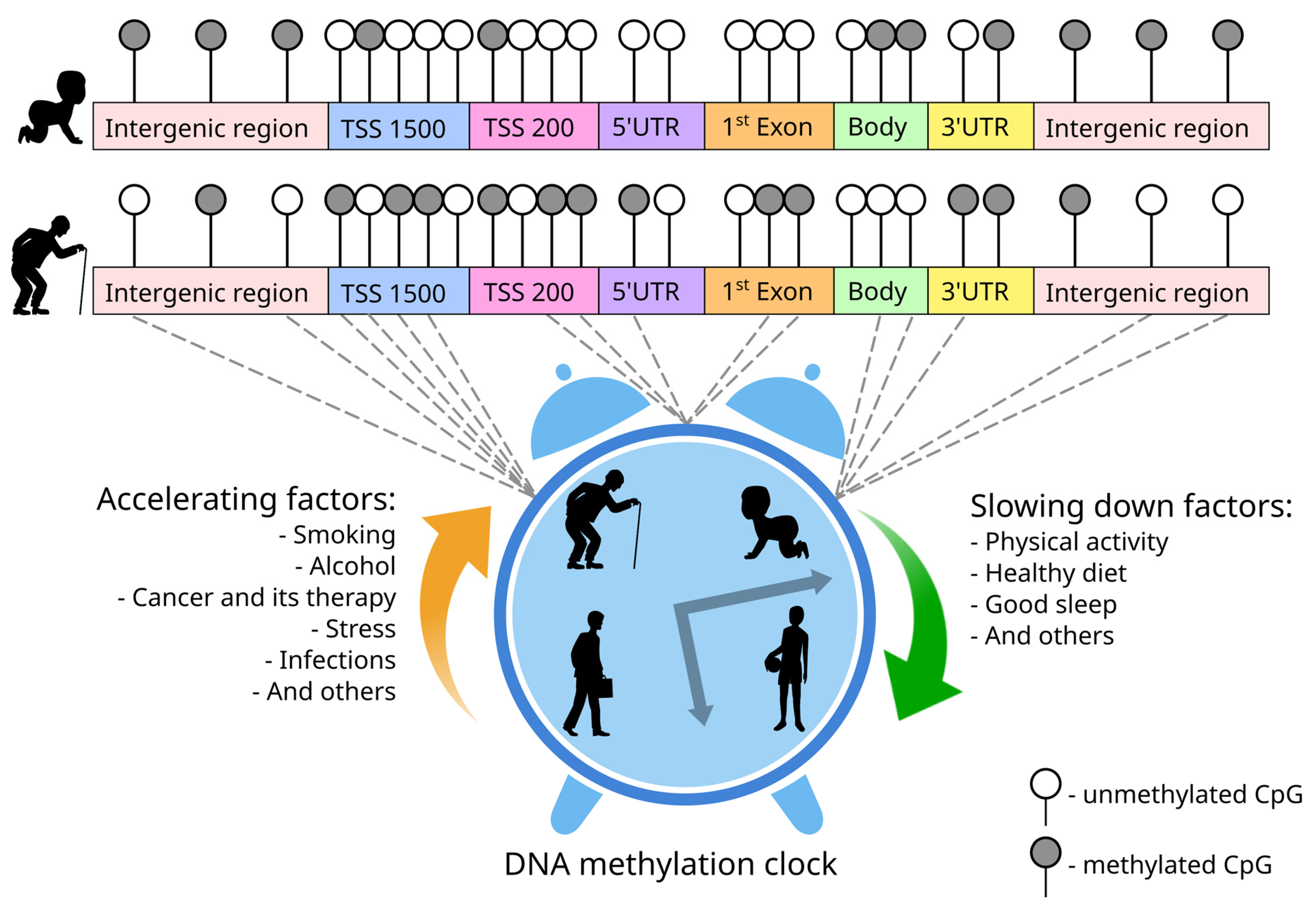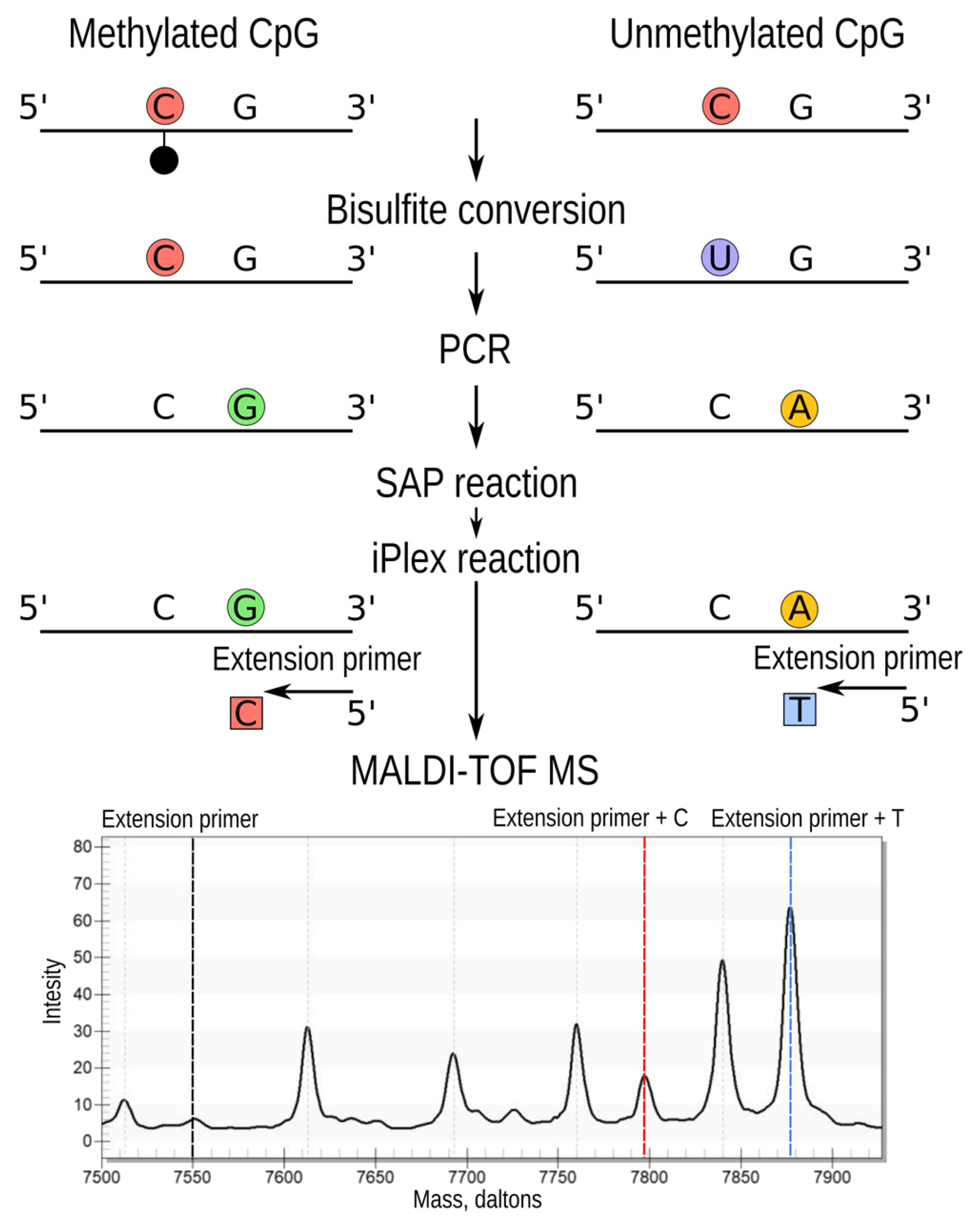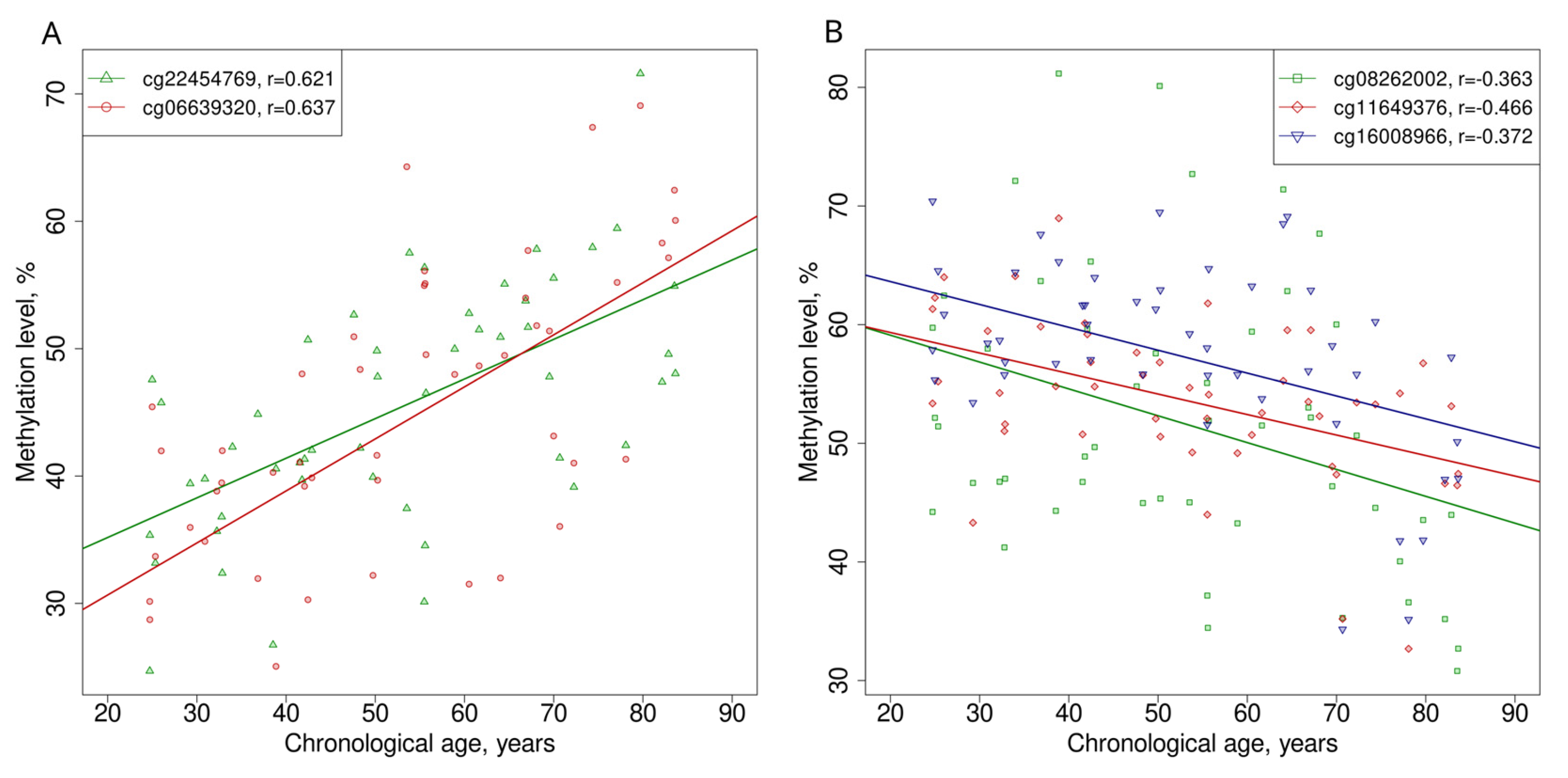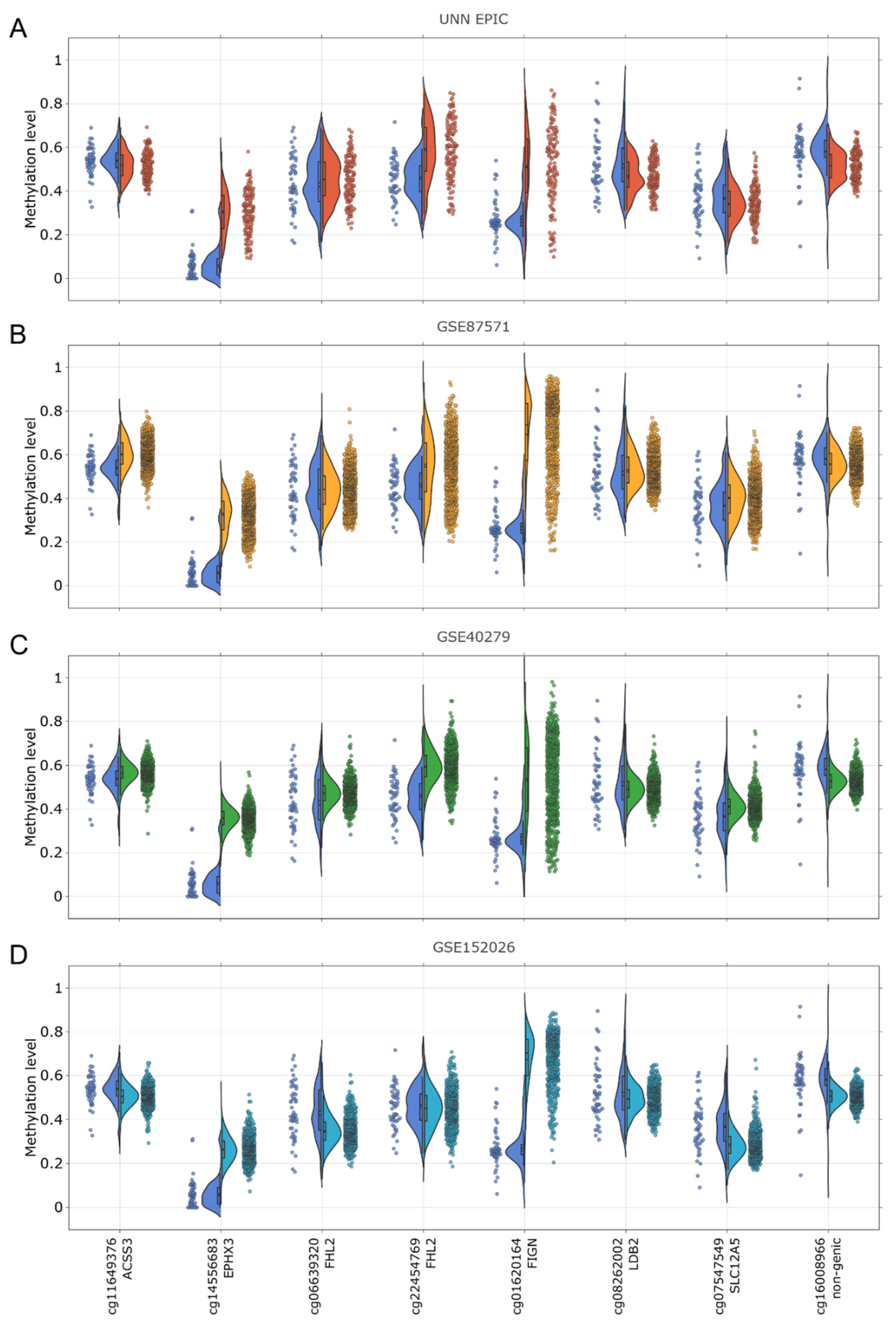Building Minimized Epigenetic Clock by iPlex MassARRAY Platform
Abstract
1. Introduction
Minimized Epigenetic Clock
| References | Disadvantages | Advantages | Technology |
|---|---|---|---|
| [20,35,37] | Short amplicons (150–200 bp) Dedicated and expensive equipment Problems with high-density CpG Difficult to analyze multiple markers at the same time | Highly quantitative Single-site resolution Fast run times Detects differences in methylation with an accuracy of up to 0.5% | Pyrosequencing |
| [20,35] | Semi-quantitative technology Possible bias of detected methylation values due to different ddNTP fluorescence intensity | High throughput Rapid quantitation of cytosine methylation Multiplexing capability | SNaPShot |
| [20,23,24] | Large amounts of genomic DNA (300 ng) The average percentage of methylation is determined if the studied points are located close to each other Possible influence of SNP on the degree of DNA methylation Dedicated equipment Sequence fragmentation may exclude some CpGs | Reproducible Fast run times Determines differences in methylation with an accuracy of 5–7% Allows simultaneous analysis of multiple CpGs in a specific area | EpiTYPER (MassARRAY system) |
| [20,36] | Low precision No single-site resolution Difficulties with the selection of primers and conditions | Simplicity Sensitive Quantitative and qualitative Equipment is easily accessible Can be multiplexed | Quantitative PCR (MS-qPCR) |
| [20,24,26] | Dedicated equipment Lack of automatic processing of results The need for optimization to improve the accuracy of genotyping | Multiplexing capability (analysis of multiple CpGs in different regions) Small amount of test sample Low launch costs Determines differences in methylation with an accuracy of 5–7% | iPlex assay (MassARRAY system) |
2. Material and Methods
2.1. Materials
2.2. CpGs Selection
2.3. Primer Design for iPlex MassARRAY
2.4. DNA Methylation Analysis of CpGs by iPlex MassARRAY
2.5. Methylation Assessment by the Illumina EPIC Array Method
2.6. Data Processing
3. Results
3.1. Correlation between DNA Methylation Level of Studied CpGs and Chronological Age
3.2. Comparison of Methylation Results Obtained by iPlex MassARRAY Technology and Illumina EPIC Array
3.3. Small iPlex MassARRAY Clocks
3.4. Genomic Localization of Age-Associated CpGs
4. Discussion
Supplementary Materials
Author Contributions
Funding
Institutional Review Board Statement
Informed Consent Statement
Data Availability Statement
Acknowledgments
Conflicts of Interest
Abbreviations
References
- Patil, V.; Ward, R.L.; Hesson, L.B. The evidence for functional non-CpG methylation in mammalian cells. Epigenetics 2014, 9, 823–828. [Google Scholar] [CrossRef] [PubMed]
- Zhang, L.; Lu, Q.; Chang, C. Epigenetics in Health and Disease. Adv. Exp. Med. Biol. 2020, 1253, 3–55. [Google Scholar] [PubMed]
- López-Otín, C.; Blasco, M.A.; Partridge, L.; Serrano, M.; Kroemer, G. The Hallmarks of Aging. Cell 2013, 153, 1194–1217. [Google Scholar] [CrossRef] [PubMed]
- Ashapkin, V.V.; Kutueva, L.I.; Vanyushin, B.F. Epigenetic Clock: Just a Convenient Marker or an Active Driver of Aging? Adv. Exp. Med. Biol. 2019, 1178, 175–206. [Google Scholar] [PubMed]
- Fraga, M.F.; Ballestar, E.; Paz, M.F.; Ropero, S.; Setien, F.; Ballestar, M.L.; Heine-Suñer, D.; Cigudosa, J.C.; Urioste, M.; Benitez, J.; et al. Epigenetic differences arise during the lifetime of monozygotic twins. Proc. Natl. Acad. Sci. USA 2005, 102, 10604–10609. [Google Scholar] [CrossRef] [PubMed]
- Talens, R.P.; Christensen, K.; Putter, H.; Willemsen, G.; Christiansen, L.; Kremer, D.; Suchiman, H.E.D.; Slagboom, P.E.; Boomsma, D.I.; Heijmans, B.T. Epigenetic variation during the adult lifespan: Cross-sectional and longitudinal data on monozygotic twin pairs. Aging Cell 2012, 11, 694–703. [Google Scholar] [CrossRef] [PubMed]
- Teschendorff, A.E.; West, J.; Beck, S. Age-associated epigenetic drift: Implications, and a case of epigenetic thrift? Hum. Mol. Genet. 2013, 22, R7–R15. [Google Scholar] [CrossRef] [PubMed]
- Pal, S.; Tyler, J.K. Epigenetics and aging. Sci. Adv. 2016, 2, e1600584. [Google Scholar] [CrossRef] [PubMed]
- Simpson, D.J.; Chandra, T. Epigenetic age prediction. Aging Cell 2021, 20, e13452. [Google Scholar] [CrossRef] [PubMed]
- Daunay, A.; Hardy, L.M.; Bouyacoub, Y.; Sahbatou, M.; Touvier, M.; Blanché, H.; Deleuze, J.-F.; How-Kit, A. Centenarians consistently present a younger epigenetic age than their chronological age with four epigenetic clocks based on a small number of CpG sites. Aging 2022, 14, 7718–7733. [Google Scholar] [CrossRef] [PubMed]
- Bocklandt, S.; Lin, W.; Sehl, M.E.; Sánchez, F.J.; Sinsheimer, J.S.; Horvath, S.; Vilain, E. Epigenetic predictor of age. PLoS ONE 2011, 6, e14821. [Google Scholar] [CrossRef] [PubMed]
- Horvath, S. DNA methylation age of human tissues and cell types. Genome Biol. 2013, 14, R115. [Google Scholar] [CrossRef] [PubMed]
- Hannum, G.; Guinney, J.; Zhao, L.; Zhang, L.; Hughes, G.; Sadda, S.; Klotzle, B.; Bibikova, M.; Fan, J.-B.; Gao, Y.; et al. Genome-wide methylation profiles reveal quantitative views of human aging rates. Mol. Cell 2013, 49, 359–367. [Google Scholar] [CrossRef] [PubMed]
- Zhang, Q.; Vallerga, C.L.; Walker, R.M.; Lin, T.; Henders, A.K.; Montgomery, G.W.; He, J.; Fan, D.; Fowdar, J.; Kennedy, M.; et al. Improved precision of epigenetic clock estimates across tissues and its implication for biological ageing. Genome Med. 2019, 11, 54. [Google Scholar] [CrossRef] [PubMed]
- Boroni, M.; Zonari, A.; Reis de Oliveira, C.; Alkatib, K.; Ochoa Cruz, E.A.; Brace, L.E.; Lott de Carvalho, J. Highly accurate skin-specific methylome analysis algorithm as a platform to screen and validate therapeutics for healthy aging. Clin. Epigenet. 2020, 12, 105. [Google Scholar] [CrossRef] [PubMed]
- Weidner, C.I.; Lin, Q.; Koch, C.M.; Eisele, L.; Beier, F.; Ziegler, P.; Bauerschlag, D.O.; Jöckel, K.-H.; Erbel, R.; Mühleisen, T.W.; et al. Aging of blood can be tracked by DNA methylation changes at just three CpG sites. Genome Biol. 2014, 15, R24. [Google Scholar] [CrossRef] [PubMed]
- Delaney, C.; Garg, S.K.; Yung, R. Analysis of DNA Methylation by Pyrosequencing. Methods Mol. Biol. 2015, 1343, 249–264. [Google Scholar] [PubMed]
- Jung, S.-E.; Lim, S.M.; Hong, S.R.; Lee, E.H.; Shin, K.-J.; Lee, H.Y. DNA methylation of the ELOVL2, FHL2, KLF14, C1orf132/MIR29B2C, and TRIM59 genes for age prediction from blood, saliva, and buccal swab samples. Forensic Sci. Int. Genet. 2019, 38, 1–8. [Google Scholar] [CrossRef] [PubMed]
- Dias, H.C.; Cordeiro, C.; Pereira, J.; Pinto, C.; Real, F.C.; Cunha, E.; Manco, L. DNA methylation age estimation in blood samples of living and deceased individuals using a multiplex SNaPshot assay. Forensic Sci. Int. 2020, 311, 110267. [Google Scholar] [CrossRef] [PubMed]
- Sabeeha, S.; Hasnain, S.E. Forensic Epigenetic Analysis: The Path Ahead. Med. Princ. Pract. 2019, 28, 301–308. [Google Scholar] [CrossRef] [PubMed]
- De Chiara, L.; Leiro-Fernandez, V.; Rodríguez-Girondo, M.; Valverde, D.; Botana-Rial, M.I.; Fernández-Villar, A. Comparison of Bisulfite Pyrosequencing and Methylation-Specific qPCR for Methylation Assessment. Int. J. Mol. Sci. 2020, 21, 9242. [Google Scholar] [CrossRef] [PubMed]
- Gensous, N.; Sala, C.; Pirazzini, C.; Ravaioli, F.; Milazzo, M.; Kwiatkowska, K.M.; Marasco, E.; De Fanti, S.; Giuliani, C.; Pellegrini, C.; et al. A Targeted Epigenetic Clock for the Prediction of Biological Age. Cells 2022, 11, 4044. [Google Scholar] [CrossRef] [PubMed]
- Freire-Aradas, A.; Girón-Santamaría, L.; Mosquera-Miguel, A.; Ambroa-Conde, A.; Phillips, C.; de Cal, M.C.; Gómez-Tato, A.; Álvarez-Dios, J.; Pospiech, E.; Aliferi, A.; et al. A common epigenetic clock from childhood to old age. Forensic Sci. Int. Genet. 2022, 60, 102743. [Google Scholar] [CrossRef] [PubMed]
- Kunze, S. Quantitative Region-Specific DNA Methylation Analysis by the EpiTYPERTM Technology. Methods Mol. Biol. 2018, 1708, 515–535. [Google Scholar] [PubMed]
- Van den Boom, D.; Ehrich, M. Mass spectrometric analysis of cytosine methylation by base-specific cleavage and primer extension methods. Methods Mol. Biol. 2009, 507, 207–227. [Google Scholar] [PubMed]
- Svidnicki, M.C.C.M.; Silva-Costa, S.M.; Ramos, P.Z.; dos Santos, N.Z.P.; Martins, F.T.A.; Castilho, A.M.; Sartorato, E.L. Screening of genetic alterations related to non-syndromic hearing loss using MassARRAY iPLEX® technology. BMC Med. Genet. 2015, 16, 85. [Google Scholar] [CrossRef] [PubMed]
- Starnawska, A.; Demontis, D.; McQuillin, A.; O’Brien, N.L.; Staunstrup, N.H.; Mors, O.; Nielsen, A.L.; Børglum, A.D.; Nyegaard, M. Hypomethylation of FAM63B in bipolar disorder patients. Clin. Epigenet. 2016, 8, 52. [Google Scholar] [CrossRef] [PubMed]
- Sutton, B.C.; Birse, R.T.; Maggert, K.; Ray, T.; Hobbs, J.; Ezenekwe, A.; Kazmierczak, J.; Mosko, M.; Kish, J.; Bullock, A.; et al. Assessment of common somatic mutations of EGFR, KRAS, BRAF, NRAS in pulmonary non-small cell carcinoma using iPLEX® HS, a new highly sensitive assay for the MassARRAY® System. PLoS ONE 2017, 12, e0183715. [Google Scholar] [CrossRef] [PubMed]
- Konwar, C.; Del Gobbo, G.F.; Terry, J.; Robinson, W.P. Association of a placental Interleukin-6 genetic variant (rs1800796) with DNA methylation, gene expression and risk of acute chorioamnionitis. BMC Med. Genet. 2019, 20, 36. [Google Scholar] [CrossRef] [PubMed]
- Giacopelli, B.; Zhao, Q.; Ruppert, A.S.; Agyeman, A.; Weigel, C.; Wu, Y.Z.; Gerber, M.M.; Rabe, K.G.; Larson, M.C.; Lu, J.; et al. Developmental subtypes assessed by DNA methylation-iPLEX forecast the natural history of chronic lymphocytic leukemia. Blood 2019, 134, 688–698. [Google Scholar] [CrossRef] [PubMed]
- Kampmann, M.L.; Meyer, O.S.; Schmidt, S.G.; Børsting, C.; Morling, N. Reproducibility of methylated CpG typing with the Illumina MiSeq. Forensic Sci. Int. Genet. Suppl. Ser. 2017, 6, e430–e432. [Google Scholar] [CrossRef][Green Version]
- Li, L.X.; Agborbesong, E.; Zhang, L.; Li, X. Investigation of epigenetics in kidney cell biology. Methods Cell Biol. 2019, 153, 255–278. [Google Scholar] [PubMed]
- Lilischkis, R.; Kneitz, H.; Kreipe, H. Methylation analysis of CpG islands. Methods Mol. Med. 2001, 57, 271–283. [Google Scholar] [PubMed]
- Leontiou, C.A.; Hadjidaniel, M.D.; Mina, P.; Antoniou, P.; Ioannides, M.; Patsalis, P.C. Bisulfite Conversion of DNA: Performance Comparison of Different Kits and Methylation Quantitation of Epigenetic Biomarkers that Have the Potential to Be Used in Non-Invasive Prenatal Testing. PLoS ONE 2015, 10, e0135058. [Google Scholar] [CrossRef] [PubMed]
- Freire-Aradas, A.; Pośpiech, E.; Aliferi, A.; Girón-Santamaría, L.; Mosquera-Miguel, A.; Pisarek, A.; Ambroa-Conde, A.; Phillips, C.; de Cal, M.A.C.; Gómez-Tato, A.; et al. A Comparison of Forensic Age Prediction Models Using Data from Four DNA Methylation Technologies. Front. Genet. 2020, 11, 932. [Google Scholar] [CrossRef] [PubMed]
- Šestáková, Š.; Šálek, C.; Remešová, H. DNA Methylation Validation Methods: A Coherent Review with Practical Comparison. Biol. Proceed. Online 2019, 21, 19. [Google Scholar] [CrossRef] [PubMed]
- King, D.E.; Sparling, A.C.; Joglekar, R.; Meyer, J.N.; Murphy, S.K. Direct comparisons of bisulfite pyrosequencing versus targeted bisulfite sequencing. MicroPubl. Biol. 2021, 2021. [Google Scholar] [CrossRef]
- Green, M.R.; Sambrook, J. Alkaline Phosphatase. Cold Spring Harb. Protoc. 2020, 2020, 100768. [Google Scholar] [CrossRef] [PubMed]
- Tian, Y.; Morris, T.J.; Webster, A.P.; Yang, Z.; Beck, S.; Feber, A.; Teschendorff, A.E. ChAMP: Updated methylation analysis pipeline for Illumina BeadChips. Bioinformatics 2017, 33, 3982–3984. [Google Scholar] [CrossRef] [PubMed]
- McCartney, D.L.; Walker, R.M.; Morris, S.W.; McIntosh, A.M.; Porteous, D.J.; Evans, K.L. Identification of polymorphic and off-target probe binding sites on the Illumina Infinium MethylationEPIC BeadChip. Genom. Data 2016, 9, 22–24. [Google Scholar] [CrossRef]
- Zhou, W.; Laird, P.W.; Shen, H. Comprehensive characterization, annotation and innovative use of Infinium DNA methylation BeadChip probes. Nucleic Acids Res. 2017, 45, e22. [Google Scholar] [CrossRef] [PubMed]
- Nordlund, J.; Bäcklin, C.L.; Wahlberg, P.; Busche, S.; Berglund, E.C.; Eloranta, M.-L.; Flaegstad, T.; Forestier, E.; Frost, B.-M.; Harila-Saari, A.; et al. Genome-wide signatures of differential DNA methylation in pediatric acute lymphoblastic leukemia. Genome Biol. 2013, 14, r105. [Google Scholar] [CrossRef] [PubMed]
- Fortin, J.-P.; Labbe, A.; Lemire, M.; Zanke, B.W.; Hudson, T.J.; Fertig, E.J.; Greenwood, C.M.; Hansen, K.D. Functional normalization of 450k methylation array data improves replication in large cancer studies. Genome Biol. 2014, 15, 503. [Google Scholar] [CrossRef] [PubMed]
- Tay, J.K.; Narasimhan, B.; Hastie, T. Elastic Net Regularization Paths for All Generalized Linear Models. J. Stat. Softw. 2023, 106, 1. [Google Scholar] [CrossRef] [PubMed]
- Chen, T.; Guestrin, C. XGBoost: A Scalable Tree Boosting System. In Proceedings of the 22nd ACM SIGKDD International Conference on Knowledge Discovery and Data Mining, KDD ’16, New York, NY, USA, 13–17 August 2016; pp. 785–794. [Google Scholar]
- Ke, G.; Meng, Q.; Finley, T.; Wang, T.; Chen, W.; Ma, W.; Ye, Q.; Liu, T.-Y. LightGBM: A Highly Efficient Gradient Boosting Decision Tree. In Advances in Neural Information Processing Systems; Curran Associates, Inc.: New York, NY, USA, 2017; Volume 30. [Google Scholar]
- Prokhorenkova, L.; Gusev, G.; Vorobev, A.; Dorogush, A.V.; Gulin, A. CatBoost: Unbiased boosting with categorical features. In Advances in Neural Information Processing Systems; Curran Associates, Inc.: New York, NY, USA, 2018; Volume 31. [Google Scholar]
- Arik, S.Ö.; Pfister, T. TabNet: Attentive Interpretable Tabular Learning. AAAI 2021, 35, 6679–6687. [Google Scholar] [CrossRef]
- Gorishniy, Y.; Rubachev, I.; Khrulkov, V.; Babenko, A. Revisiting Deep Learning Models for Tabular Data. In Advances in Neural Information Processing Systems; Curran Associates, Inc.: New York, NY, USA, 2021. [Google Scholar]
- Panja, S.; Hayati, S.; Epsi, N.J.; Parrott, J.S.; Mitrofanova, A. Integrative (epi) Genomic Analysis to Predict Response to Androgen-Deprivation Therapy in Prostate Cancer. EBioMedicine 2018, 31, 110–121. [Google Scholar] [CrossRef] [PubMed]
- Solomon, O.; MacIsaac, J.; Quach, H.; Tindula, G.; Kobor, M.S.; Huen, K.; Meaney, M.J.; Eskenazi, B.; Barcellos, L.F.; Holland, N. Comparison of DNA methylation measured by Illumina 450K and EPIC BeadChips in blood of newborns and 14-year-old children. Epigenetics 2018, 13, 655–664. [Google Scholar] [CrossRef] [PubMed]
- Montesanto, A.; D’aquila, P.; Lagani, V.; Paparazzo, E.; Geracitano, S.; Formentini, L.; Giacconi, R.; Cardelli, M.; Provinciali, M.; Bellizzi, D.; et al. A New Robust Epigenetic Model for Forensic Age Prediction. J. Forensic Sci. 2020, 65, 1424–1431. [Google Scholar] [CrossRef] [PubMed]
- Tian, H.-X.; Zhang, X.-C.; Wang, Z.; Chen, J.-G.; Chen, S.-L.; Guo, W.-B.; Wu, Y.-L. Establishment and application of a multiplex genetic mutation-detection method of lung cancer based on MassARRAY platform. Cancer Biol. Med. 2016, 13, 68–76. [Google Scholar] [CrossRef] [PubMed]
- Liu, Q.; Hua, M.; Yan, S.; Zhang, C.; Wang, R.; Yang, X.; Han, F.; Hou, M.; Ma, D. Immunorelated gene polymorphisms associated with acute myeloid leukemia. Clin. Exp. Immunol. 2020, 201, 266–278. [Google Scholar] [CrossRef]
- Yan, Y.; Jin, X.; Wang, X.; Zhang, C.; Zhang, Q.; Zheng, L.; Feng, X.; Hao, S.; Gao, H.; Ma, X. Screening of PAH Common Mutations in Chinese Phenylketonuria Patients Using iPLEX MALDI-TOF MS. ACS Omega 2020, 5, 1805–1812. [Google Scholar] [CrossRef] [PubMed]
- Daghestani, M.; Othman, N.; Omair, M.A.; Alenzi, F.; Omair, M.A.; Alqurtas, E.; Amin, S.; Warsy, A. Single Nucleotide Polymorphisms Associated with Rheumatoid Arthritis in Saudi Patients. J. Clin. Med. 2023, 12, 4944. [Google Scholar] [CrossRef] [PubMed]
- Zhao, Y.; Zhang, Q.; Zhang, X.; Zhang, Y.; Lu, Y.; Ma, X.; Li, W.; Niu, X.; Zhang, G.; Chang, M.; et al. The roles of MMP8/MMP10 polymorphisms in ischemic stroke susceptibility. Brain Behav. 2022, 12, e2797. [Google Scholar] [CrossRef] [PubMed]
- Al-Eitan, L.N.; Alghamdi, M.A.; Al Momani, R.O.; Aljamal, H.A.; Abdalla, A.M.; Mohammed, H.M. Genetic predisposition of alopecia areata in jordanians: A case-control study. Heliyon 2022, 8, e09184. [Google Scholar] [CrossRef] [PubMed]
- Langie, S.A.S.; Moisse, M.; Szic, K.S.V.; Van Der Plas, E.; Koppen, G.; De Prins, S.; Louwies, T.; Nelen, V.; Van Camp, G.; Lambrechts, D.; et al. GLI2 promoter hypermethylation in saliva of children with a respiratory allergy. Clin. Epigenet. 2018, 10, 50. [Google Scholar] [CrossRef] [PubMed]
- Ludwig, B.; Carlberg, L.; Kienesberger, K.; Swoboda, P.; Mitschek, M.M.M.; Bernegger, A.; Koller, R.; Inaner, M.; Senft, B.; Meisner, L.; et al. Monoamino Oxidase A Gene Single-Nucleotide Polymorphisms and Methylation Status and the Risk of Violent Suicide Attempts in Affective Disorder Patients. Front. Psychiatry 2021, 12, 667191. [Google Scholar] [CrossRef] [PubMed]
- Bergstedt, J.; Azzou, S.A.K.; Tsuo, K.; Jaquaniello, A.; Urrutia, A.; Rotival, M.; Lin, D.T.S.; MacIsaac, J.L.; Kobor, M.S.; Albert, M.L.; et al. The immune factors driving DNA methylation variation in human blood. Nat. Commun. 2022, 13, 5895. [Google Scholar] [CrossRef] [PubMed]
- Lioznova, A.V.; Khamis, A.M.; Artemov, A.V.; Besedina, E.; Ramensky, V.; Bajic, V.B.; Kulakovskiy, I.V.; Medvedeva, Y.A. CpG traffic lights are markers of regulatory regions in human genome. BMC Genom. 2019, 20, 102. [Google Scholar] [CrossRef] [PubMed]
- Roels, J.; Thénoz, M.; Szarzyńska, B.; Landfors, M.; De Coninck, S.; Demoen, L.; Provez, L.; Kuchmiy, A.; Strubbe, S.; Reunes, L.; et al. Aging of preleukemic thymocytes drives CpG island hypermethylation in T-cell acute lymphoblastic leukemia. Blood Cancer Discov. 2020, 1, 274–289. [Google Scholar] [CrossRef]
- Arechederra, M.; Daian, F.; Yim, A.; Bazai, S.K.; Richelme, S.; Dono, R.; Saurin, A.J.; Habermann, B.H.; Maina, F. Publisher Correction: Hypermethylation of gene body CpG islands predicts high dosage of functional oncogenes in liver cancer. Nat. Commun. 2018, 9, 3976. [Google Scholar] [CrossRef] [PubMed]
- Jjingo, D.; Conley, A.B.; Yi, S.V.; Lunyak, V.V.; Jordan, I.K. On the presence and role of human gene-body DNA methylation. Oncotarget 2012, 3, 462–474. [Google Scholar] [CrossRef] [PubMed]
- Marttila, S.; Kananen, L.; Häyrynen, S.; Jylhävä, J.; Nevalainen, T.; Hervonen, A.; Jylhä, M.; Nykter, M.; Hurme, M. Ageing-associated changes in the human DNA methylome: Genomic locations and effects on gene expression. BMC Genom. 2015, 16, 179. [Google Scholar] [CrossRef]
- Zhang, J.; Fu, H.; Xu, Y. Age Prediction of Human Based on DNA Methylation by Blood Tissues. Genes 2021, 12, 870. [Google Scholar] [CrossRef]
- Naue, J.; Hoefsloot, H.C.J.; Mook, O.R.F.; Rijlaarsdam-Hoekstra, L.; van der Zwalm, M.C.H.; Henneman, P.; Kloosterman, A.D.; Verschure, P.J. Chronological age prediction based on DNA methylation: Massive parallel sequencing and random forest regression. Forensic Sci. Int. Genet. 2017, 31, 19–28. [Google Scholar] [CrossRef] [PubMed]
- Arpón, A.; Milagro, F.I.; Ramos-Lopez, O.; Mansego, M.L.; Riezu-Boj, J.-I.; Martínez, J.A. Methylome-Wide Association Study in Peripheral White Blood Cells Focusing on Central Obesity and Inflammation. Genes 2019, 10, 444. [Google Scholar] [CrossRef] [PubMed]
- Jo, J.; Song, Y.; Yoon, D.; Lee, C.G.; Won, S. Genome-wide assessment reveals a significant association between ACSS3 and physical activity. Genes Brain Behav. 2023, 22, e12834. [Google Scholar] [CrossRef] [PubMed]
- Tan, Q.; Heijmans, B.T.; Hjelmborg, J.V.B.; Soerensen, M.; Christensen, K.; Christiansen, L. Epigenetic drift in the aging genome: A ten-year follow-up in an elderly twin cohort. Int. J. Epidemiol. 2016, 45, 1146–1158. [Google Scholar] [CrossRef] [PubMed]
- Karmaus, W.; Chen, S. Changes in blood DNA methylation and incomplete adjustment for blood cell composition. Int. J. Epidemiol. 2017, 46, 1714–1717. [Google Scholar] [CrossRef]
- Florath, I.; Butterbach, K.; Müller, H.; Bewerunge-Hudler, M.; Brenner, H. Cross-sectional and longitudinal changes in DNA methylation with age: An epigenome-wide analysis revealing over 60 novel age-associated CpG sites. Hum. Mol. Genet. 2014, 23, 1186–1201. [Google Scholar] [CrossRef]
- Kananen, L.; Marttila, S.; Nevalainen, T.; Jylhävä, J.; Mononen, N.; Kähönen, M.; Raitakari, O.T.; Lehtimäki, T.; Hurme, M. Aging-associated DNA methylation changes in middle-aged individuals: The Young Finns study. BMC Genom. 2016, 17, 103. [Google Scholar] [CrossRef] [PubMed]
- Aliferi, A.; Sundaram, S.; Ballard, D.; Freire-Aradas, A.; Phillips, C.; Lareu, M.V.; Court, D.S. Combining current knowledge on DNA methylation-based age estimation towards the development of a superior forensic DNA intelligence tool. Forensic Sci. Int. Genet. 2022, 57, 102637. [Google Scholar] [CrossRef] [PubMed]
- Bacalini, M.G.; Deelen, J.; Pirazzini, C.; De Cecco, M.; Giuliani, C.; Lanzarini, C.; Ravaioli, F.; Marasco, E.; van Heemst, D.; Suchiman, H.E.D.; et al. Systemic Age-Associated DNA Hypermethylation of ELOVL2 Gene: In Vivo and In Vitro Evidences of a Cell Replication Process. J. Gerontol. A Biol. Sci. Med. Sci. 2017, 72, 1015–1023. [Google Scholar] [CrossRef] [PubMed]
- Fukuda, A.; Watanabe, M. Pathogenic potential of human SLC12A5 variants causing KCC2 dysfunction. Brain Res. 2019, 1710, 1–7. [Google Scholar] [CrossRef] [PubMed]
- Lemesh, V.A.; Kipen, V.N.; Bahdanava, M.V.; Burakova, A.A.; Bulgak, A.G.; Bayda, A.V.; Bruskin, S.A.; Zotova, O.V.; Dobysh, O.I. Determination of Human Chronological Age from Biological Samples Based on the Analysis of Methylation of CpG Dinucleotides. Russ. J. Genet. 2021, 57, 1389–1397. [Google Scholar] [CrossRef]
- Ho Lee, M.; Hee Hwang, J.; Min Seong, K.; Jin Ahn, J.; Jun Kim, S.; Yong Hwang, S.; Lim, S.-K. Application of droplet digital PCR method for DNA methylation-based age prediction from saliva. Leg. Med. 2022, 54, 101992. [Google Scholar] [CrossRef] [PubMed]
- Hao, T.; Guo, J.; Liu, J.; Wang, J.; Liu, Z.; Cheng, X.; Li, J.; Ren, J.; Li, Z.; Yan, J.; et al. Predicting human age by detecting DNA methylation status in hair. Electrophoresis 2021, 42, 1255–1261. [Google Scholar] [CrossRef] [PubMed]
- Yusipov, I.; Bacalini, M.G.; Kalyakulina, A.; Krivonosov, M.; Pirazzini, C.; Gensous, N.; Ravaioli, F.; Milazzo, M.; Giuliani, C.; Vedunova, M.; et al. Age-related DNA methylation changes are sex-specific: A comprehensive assessment. Aging 2020, 12, 24057–24080. [Google Scholar] [CrossRef] [PubMed]
- Zhou, B.; Wang, J.; Gao, J.; Xie, J.; Chen, Y. Fidgetin as a potential prognostic biomarker for hepatocellular carcinoma. Int. J. Med. Sci. 2020, 17, 2888–2894. [Google Scholar] [CrossRef] [PubMed]
- Bai, G.; Song, J.; Yuan, Y.; Chen, Z.; Tian, Y.; Yin, X.; Niu, Y.; Liu, J. Systematic analysis of differentially methylated expressed genes and site-specific methylation as potential prognostic markers in head and neck cancer. J. Cell. Physiol. 2019, 234, 22687–22702. [Google Scholar] [CrossRef] [PubMed]
- Pellegrini, C.; Pirazzini, C.; Sala, C.; Sambati, L.; Yusipov, I.; Kalyakulina, A.; Ravaioli, F.; Kwiatkowska, K.M.; Durso, D.F.; Ivanchenko, M.; et al. A Meta-Analysis of Brain DNA Methylation Across Sex, Age, and Alzheimer’s Disease Points for Accelerated Epigenetic Aging in Neurodegeneration. Front. Aging Neurosci. 2021, 13, 639428. [Google Scholar] [CrossRef] [PubMed]






| GSE152026 MAE | GSE55763 MAE | GSE40279 MAE | GSE87571 MAE | UNN EPIC MAE | UNN MassARRAY Validation Best MAE | UNN MassARRAY Validation (MAE) ± STD | Model | Type |
|---|---|---|---|---|---|---|---|---|
| 14.98 | 8.67 | 8.71 | 11.97 | 12.00 | 9.67 | 11.23 ± 1.37 | Elastic Net | Linear |
| 10.93 | 6.83 | 10.13 | 8.12 | 10.95 | 8.20 | 11.61 ± 3.41 | XGBoost | GBDT |
| 9.93 | 14.00 | 9.36 | 11.75 | 10.13 | 6.91 | 11.94 ± 3.35 | LightGBM | |
| 10.46 | 5.07 | 8.16 | 6.59 | 8.50 | 6.07 | 9.37 ± 2.94 | CatBoost | |
| 10.65 | 9.48 | 10.72 | 9.41 | 8.31 | 7.98 | 10.62 ± 1.54 | MLP | DNN |
| 8.34 | 7.67 | 7.13 | 6.83 | 8.08 | 5.99 | 8.67 ± 2.65 | TabNet | |
| 7.73 | 7.28 | 6.30 | 7.46 | 6.22 | 6.12 | 9.25 ± 3.28 | FT-Transformer |
| GSE152026 | GSE55763 | GSE40279 | GSE87571 | UNN EPIC | Clock |
|---|---|---|---|---|---|
| 8.34 | 7.67 | 7.13 | 6.83 | 8.08 | MassARRAY Age |
| 5.05 | 7.02 | 4.73 | 5.77 | 13.45 | DNAmAgeHannum |
| 8.85 | 6.20 | 5.34 | 4.70 | 6.41 | DNAmAge |
| 6.01 | 4.97 | 7.95 | 5.03 | 10.94 | DNAmPhenoAge |
| 4.73 | 5.25 | 8.89 | 7.57 | 13.17 | DNAmGrimAge |
| 11.28 | 5.50 | 6.35 | 6.19 | 8.04 | PCHorvath1 |
| 8.58 | 4.82 | 6.77 | 7.52 | 10.48 | PCHorvath2 |
| 12.57 | 8.76 | 5.65 | 10.33 | 7.65 | PCHannum |
| 5.05 | 4.29 | 6.82 | 5.22 | 4.93 | PCPhenoAge |
| 15.74 | 12.87 | 10.59 | 12.19 | 8.60 | PCGrimAge |
Disclaimer/Publisher’s Note: The statements, opinions and data contained in all publications are solely those of the individual author(s) and contributor(s) and not of MDPI and/or the editor(s). MDPI and/or the editor(s) disclaim responsibility for any injury to people or property resulting from any ideas, methods, instructions or products referred to in the content. |
© 2024 by the authors. Licensee MDPI, Basel, Switzerland. This article is an open access article distributed under the terms and conditions of the Creative Commons Attribution (CC BY) license (https://creativecommons.org/licenses/by/4.0/).
Share and Cite
Davydova, E.; Perenkov, A.; Vedunova, M. Building Minimized Epigenetic Clock by iPlex MassARRAY Platform. Genes 2024, 15, 425. https://doi.org/10.3390/genes15040425
Davydova E, Perenkov A, Vedunova M. Building Minimized Epigenetic Clock by iPlex MassARRAY Platform. Genes. 2024; 15(4):425. https://doi.org/10.3390/genes15040425
Chicago/Turabian StyleDavydova, Ekaterina, Alexey Perenkov, and Maria Vedunova. 2024. "Building Minimized Epigenetic Clock by iPlex MassARRAY Platform" Genes 15, no. 4: 425. https://doi.org/10.3390/genes15040425
APA StyleDavydova, E., Perenkov, A., & Vedunova, M. (2024). Building Minimized Epigenetic Clock by iPlex MassARRAY Platform. Genes, 15(4), 425. https://doi.org/10.3390/genes15040425






